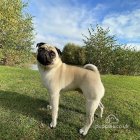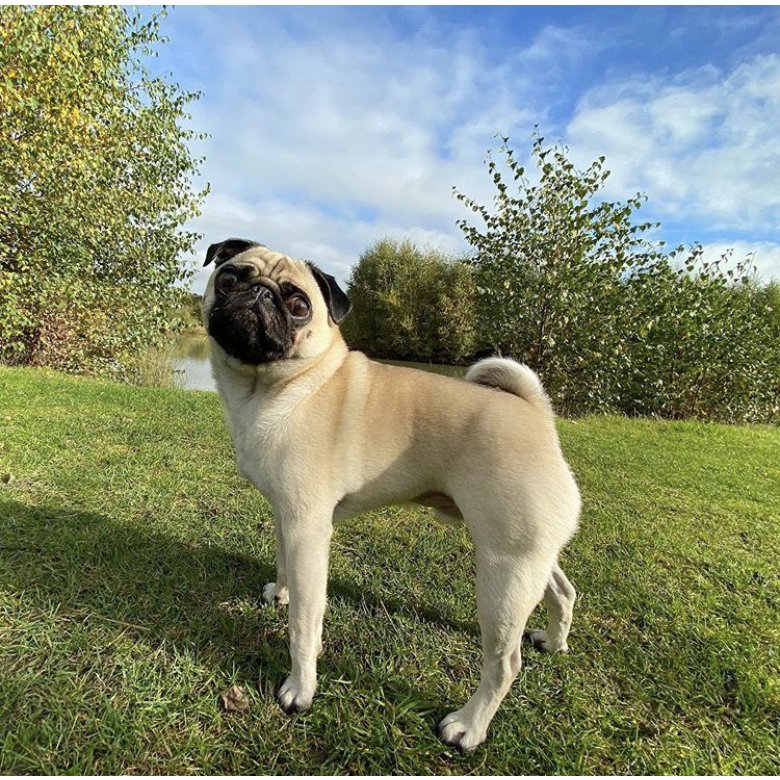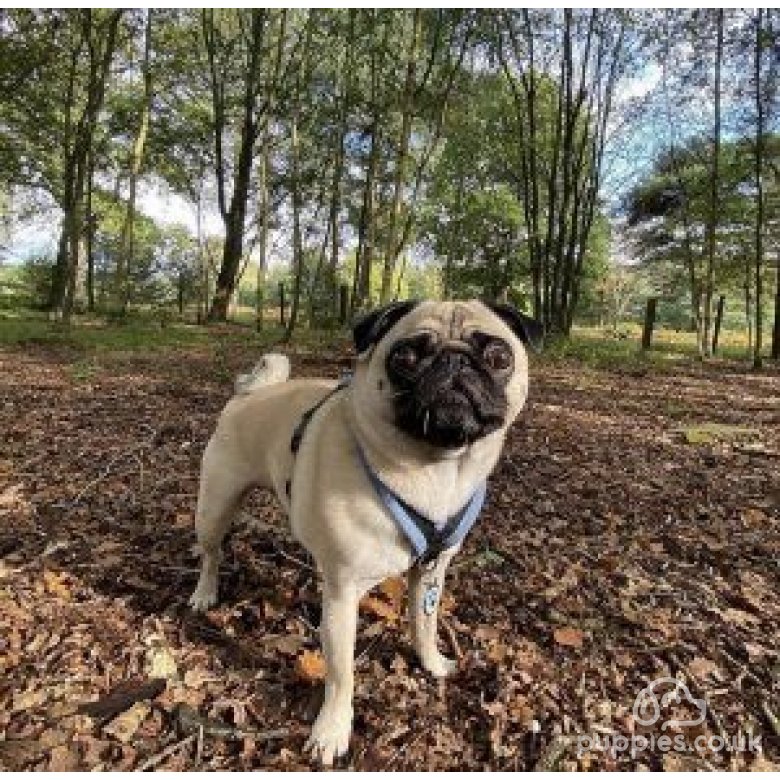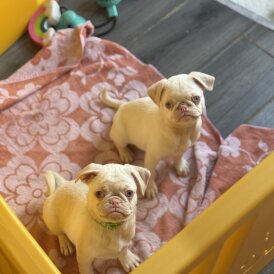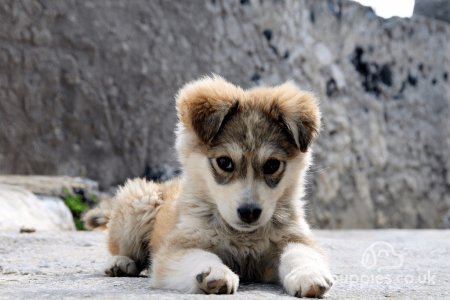Why Pugs are great
Small yet sturdy, Pugs are loyal, personality-filled dogs with an exhibitionist streak. They love humans, and are always happy when sitting on the lap of their owner. They are adaptable and energetic, and would do well in any environment — a Pug will be equally at home in a large bustling household, or a small apartment. Some highlights:
These playful dogs will brighten up your home with their clownish character.
They’re affectionate and sweet, and have bags of love for all humans.
Though they’re energetic, their compact size means they don’t need huge amounts of exercise.
They are short-coated, and low maintenance for grooming.
Things to consider when looking at Pugs for Sale
Though Pugs are on the whole a lovely breed, as with all dogs there are some important things to consider before buying your Pug puppy. Some downsides to the Pug:
Their high energy levels can sometimes be overwhelming, and they may whirl uncontrollably around your household.
This brachycephalic breed can be prone to certain health conditions.
They have a tendency to snore, loudly!
Pugs can prove challenging to housebreak, and may require crate training.
History of Pugs
Pugs originated in ancient China as far back as the Han dynasty, when they were bred as luxury companions for emperors. The dogs were so revered that they occasionally had their own quarters and servants within the royal palace, and lower class people were banned from owning them. It is believed that the breed made its way to Europe by being smuggled in the ships of explorers. The first Pug was seen in England in the 17th century, and was owned by William III. In the mid-1800s, a new kind of Pug was bred in China with a shorter nose and legs, and became popular in England as it was favoured by Queen Victoria. Today Pugs are hugely popular, and have even appeared in Hollywood films such as Men in Black.
Appearance
Known for their compact size, sweet, flat faces and prominent eyes, Pugs have an adorable appearance that endears them to anyone who meets them. They have a robust, square posture and strong necks. Their coats are glossy and smooth, and their ears feel like velvet to the touch.
How big is the pug?
An average pug will stand between 25 and 36cm at the withers.
How heavy is a pug?
Both male and female pugs can weigh anywhere between 6.3kg and 81.kg.
What Colour is the Pug?
Pugs are typically either fawn-coloured or black, with potential for different coloured tints in the fawn variety.
Temperament
Sweet and loving, Pugs are happiest when in human company. They were bred to be lapdogs and companions, and they excel in this role (provided their love is equally reciprocated!). They love to show off, and their zany personality means they will always be the centre of attention. They have a great sense of humour, and are affectionate to everyone they meet.
Do Pugs make good guard dogs?
Pugs do not make great guard dogs — their compact size means they are unlikely to intimidate intruders, and they are so affectionate by nature that they are likely to try and befriend anyone who attempts to enter the house.
Do Pugs bark a lot?
Pugs are not especially vocal dogs, and they can be taught not to bark excessively. However, this people-oriented breed may develop separation anxiety if not shown enough attention by their owners, and this may result in barking issues.
Are Pugs easy to train?
Pugs are relatively easy to train, but they can have an independent and wilful streak which might prove challenging. Owners would do well to establish consistent boundaries, and use lots of positive reinforcement.
Are Pugs playful?
Pugs are very playful dogs, and they love to attract their owner’s attention with their silly antics. Their cheeky personalities charm everyone they meet, and would be an entertaining addition to any household.
Are Pugs good with children?
Pugs are sweet and affectionate to everyone they meet, so they are excellent around children. Their sturdiness also means that they are not in danger of being injured by younger children. However, they are not the most active of dogs so children wanting to play fetch are likely to be disappointed.
Are Pugs good with other pets?
Pugs are trustworthy and likely to get on with all other animals, providing they have been properly trained and socialised from a young age.
Can I leave a Pug Alone?
As mentioned, Pugs are affectionate companion dogs who crave human attention and may develop separation anxiety if left alone for long periods of time. These dogs are most suitable for households which are regularly occupied.
Health
Although they are generally healthy and sturdy, Pugs are a brachycephalic breed and as a result they may be prone to develop certain health issues. Their prominent eyes may also be susceptible to injury, and sight problems.
How long do Pugs live?
Pugs tend to live for between 12 and 14 years when properly cared for.
How much exercise does a Pug need?
Although Pugs are an energetic breed, they do not need huge amounts of exercise. They are indoor dogs at heart, but should be taken outside for up to an hour a day. In the warmer months, they should be exercised during the cooler hours of the day, as they are susceptible to overheating. In the colder months, owners should invest in a coat for their Pug, as they can be reluctant to go outside in cold weather.
What are Pugs Common health issues?
Pugs are susceptible to eye problems such as dry eye, proptosis, distichiasis and progressive retinal atrophy, and Pug dog encephalitis — a fatal brain disease which is unique to Pugs, and impossible to diagnose until after the dog dies. They may also have mobility issues resulting from hemi-vertebrae (misshaped vertebrae, a condition common in short-nosed breeds), or hip dysplasia. Owners would do well to question their breeders about health guarantees for these conditions.
Care
How much space do I need for a Pug?
Pugs are very adaptable dogs, so can be kept in small or large households. Owners should be aware that they are an indoor breed and should not be left outdoors for long periods of time.
What should I feed my Pug?
A Pug should be served between 1/2 and 1 cup of dry food a day, across two meals.
How much grooming do Pugs need?
Pugs are a short-coated, low maintenance breed, but they do still shed a reasonable amount.
Average costs
How much does it cost to keep a Pug?
As a rough guide in pricing: Cost to buy: roughly £700 for a well-bred Pug puppy Other costs (Vet, Food etc): £40-80 per month
Specific Buying Guide
You can read our general buying guide here (/advice-on-buying-a-puppy/), with the most important thing being going to view your Pug Puppy, seeing it with its mother, and checking the quality of the breeder. More specifically, here is some Pug puppy buying advice:
Pug breed clubs have warned prospective buyers of scams where advertisements of Pug puppies request money upfront, then never deliver the dog.
Due to the popularity of the breed, many breeders breed Pugs very quickly without acquiring the proper health guarantees. Prospective buyers should research the breeders properly before buying, and also make sure that the dog has not been imported from elsewhere.
Other reading, Adopting Pug Puppies and Rescue Organisations
A big thank you to the following sources who helped to shape this article: https://pugdogclub.org.uk/ https://pugwelfare-rescue.org.uk/ https://www.pughealth.org.uk/ https://www.thekennelclub.org.uk/services/public/breed/display.aspx?id=6164







